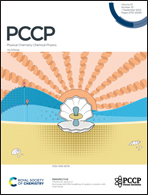Theoretical investigation on the functional group modulation of UV-Vis absorption profiles of triphenylamine derivatives†
Abstract
Understanding the functional group modulation of electronic structure and excitation is pivotal to the design of organic small molecules (OSMs) for photoelectric applications. In this study, we employed density functional theory (DFT) and time-dependent DFT (TDDFT) calculations to explore the unique absorption character of four triphenylamine photosensitizers. The various conformations were investigated given the multiple single bonds in the compounds, and the resemblance in the electronic structure of different conformations is affirmed because the coplanarity and consequent long-range conjugation is maintained regardless of the orientation of the flexible blocks. Six functionals were evaluated, and MN15 was found to successfully reproduce the intense secondary absorption peak for the double 3,4-ethylenedioxythiophene (EDOT) modified sensitizer over B3LYP, PBE0, M062X, CAM-B3LYP, and ωB97XD. The introduction of EDOT gives rise to a new excited state S4, which is a local excitation constrained in the EDOT substituent triphenylamine block. This new excited state S4, in combination with inherent S2 and S3 derived from prototype molecule TPA-Pyc, jointly contributes to the hump of the secondary absorption peak of ETE-Pyc and finally affects the light-harvesting ability of the dye-sensitized TiO2 photoanode. The current findings provide guidance toward the rational design of OSMs with good light-harvest ability.



 Please wait while we load your content...
Please wait while we load your content...